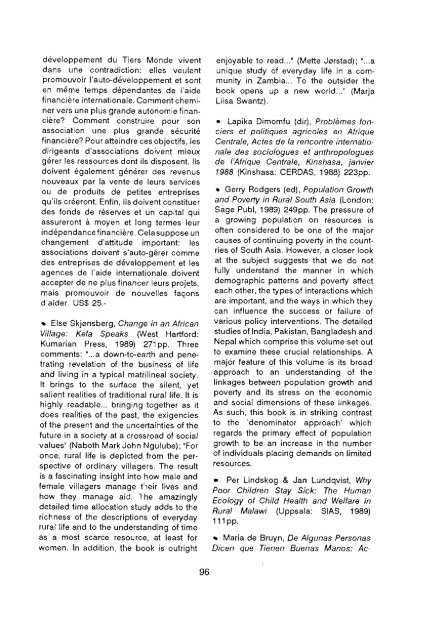ifda dossier 74 - Dag Hammarskjöld Foundation
ifda dossier 74 - Dag Hammarskjöld Foundation
ifda dossier 74 - Dag Hammarskjöld Foundation
You also want an ePaper? Increase the reach of your titles
YUMPU automatically turns print PDFs into web optimized ePapers that Google loves.
developpement du Tiers Monde vivent<br />
dans une contradiction: elles veulent<br />
promouvoir I'auto-developpement et sent<br />
en meme temps dependantes de I'aide<br />
financiere internationale. Comment chemi-<br />
ner vers une plus grande autonomiefinan-<br />
ciere? Comment construire pour son<br />
association une plus grande securite<br />
financiere? Pour atteindre ces objectifs, les<br />
dirigeants d'associations doivent mieux<br />
gerer les ressources dont ils disposent. 11s<br />
doivent egalement gknerer des revenus<br />
nouveaux par la vente de leurs services<br />
ou de produits de petites entreprises<br />
qu'ils creeront. Enfin, ils doivent constituer<br />
des fonds de reserves et un capital qui<br />
assureront a moyen et long termes leur<br />
independancefinanciere. Celasuppose un<br />
changement d'attitude important: les<br />
associations doivent s'auto-gerer comme<br />
des entreprises de d6veloppement et les<br />
agences de I'aide internationale doivent<br />
accepter de ne plus financer leurs projets,<br />
mais promouvoir de nouvelles faqons<br />
d'aider. US$ 25.-<br />
Else Skjonsberg, Change in an African<br />
Village: Kefa Speaks (West Hartford:<br />
Kumarian Press, 1989) 271 pp. Three<br />
comments: "... a down-to-earth and pene-<br />
trating revelation of the business of life<br />
and living in a typical matrilineal society.<br />
It brings to the surface the silent, yet<br />
salient realities of traditional rural life. It is<br />
highly readable ... bringing together as it<br />
does realities of the past, the exigencies<br />
of the present and the uncertainties of the<br />
future in a society at a crossroad of social<br />
values" (Naboth Mark John Ngulube); "For<br />
once, rural life is depicted from the per-<br />
spective of ordinary villagers. The result<br />
is a fascinating insight into how male and<br />
female villagers manage t'ieir lives and<br />
how they manage aid. -!he amazingly<br />
detailed time allocation study adds to the<br />
richness of the descriptions of everyday<br />
rural life and to the understanding of time<br />
as a most scarce resource, at least for<br />
women. In addition, the book is outright<br />
enjoyable to read ... "(Mette Jorstad); '...a<br />
unique study of everyday life in a com-<br />
munity in Zambia ... To the outsider the<br />
book opens up a new world ..." (Marja<br />
Liisa Swantz).<br />
Lapika Dimomfu (dir), Problemes fon-<br />
ciers et politiques agricoles en Afrique<br />
Centrale, Actes de la rencontre internatio-<br />
nale des sociologues et anthropologues<br />
de I'Afrique Centrale, Kinshasa, janvier<br />
7988 (Kinshasa: CERDAS, 1988) 223pp.<br />
Gerry Rodgers (ed), Population Growth<br />
and Poverty in Rural South Asia (London:<br />
Sage Publ, 1989) 249pp. The pressure of<br />
a growing population on resources is<br />
often considered to be one of the major<br />
causes of continuing poverty in the count-<br />
ries of South Asia. However, a closer look<br />
at the subject suggests that we do not<br />
fully understand the manner in which<br />
demographic patterns and poverty affect<br />
each other, the types of interactions which<br />
are important, and the ways in which they<br />
can influence the success or failure of<br />
various policy interventions. The detailed<br />
studies of India, Pakistan, Bangladesh and<br />
Nepal which comprise this volume set out<br />
to examine these crucial relationships. A<br />
major feature of this volume is its broad<br />
approach to an understanding of the<br />
linkages between population growth and<br />
poverty and its stress on the economic<br />
and social dimensions of these linkages.<br />
As such, this book is in striking contrast<br />
to the 'denominator approach' which<br />
regards the primary effect of population<br />
growth to be an increase in the number<br />
of individuals placing demands on limited<br />
resources.<br />
Per Lindskog & Jan Lundqvist, Why<br />
Poor Children Stay Sick: The Human<br />
Ecology of Child Health and Welfare in<br />
Rural Malawi (Uppsala: SIAS, 1989)<br />
11 1 pp.<br />
Maria de Bruyn, De Algunas Personas<br />
Dicen que Tienen Buenas Manos: Ac-
















